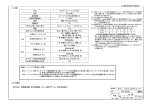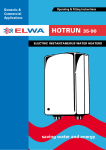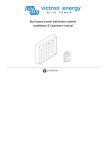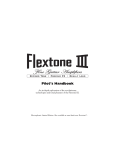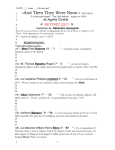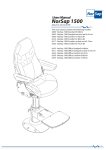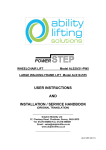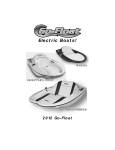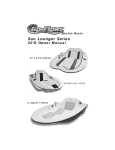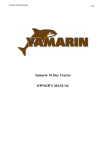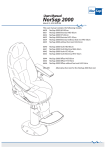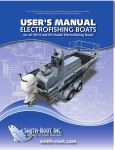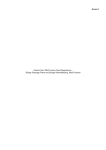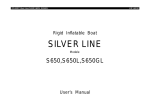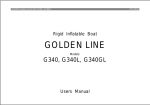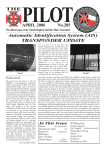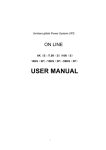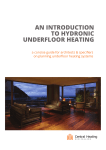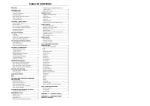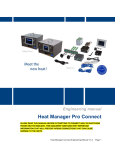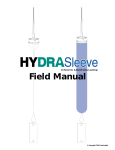Download CAT USER MANUAL MASTER 2016
Transcript
RowingSolutions Ltd Owner’s Manual CAT2016 Page 1 Owner's Manual CAT2016 Please keep this manual in a secure place and hand it over to the new owner when you sell the craft. If this is your first craft, or you are changing to a type of craft you are not familiar with, for your own comfort and safety, ensure that you obtain handling and operating experience before assuming command of the craft. Any boat dealer or national sailing federation or yacht club will be pleased to advise you of local sea schools, or competent instructors. 66 Highfield Park, Wargrave, Reading. RG10 8LE. UK Tel: +44(0)1189 401 041 Mobile: +44(0)7860 224 007 E-mail: [email protected] Web: www.rowingsolutions.com RowingSolutions Ltd Owner’s Manual CAT2016 Page 2 CONTENTS Section WELCOME 1 Boating Experience 1.1 Responsibility 1.2 ABOUT THIS MANUAL 2 Original Equipment Manufacturer (OEM) Manuals 2.1 Safety Labels 2.2 Explanation of Hazard Warnings 2.3 GENERAL ARRANGEMENT 3 Boat Identification & CE Marking Classification 3.1 RCD Design Category Explanation 3.1.1 Principal Dimensions 3.2 Hull Size 3.2.1 Maximum Recommended 3.2.2 Power Weights 3.2.3 SYSTEMS DESCRIPTIONS 4 Bilge Pumps 4.1 Electrical System 4.2 DC System 4.2.1 Fuel System 4.3 Steering System 4.4 PRE-LAUNCH OBSERVATIONS 5 Recommended Safety Equipment 5.1 Risk of Loss of Stability 5.2 Risk of Flooding 5.2.2 Strainers 5.3 Risk of Fire 5.4 Risk of Falling Overboard 5.5 NAVIGATION & OPERATION 6 Use of Engines 6.1 Handling Characteristics 6.2 Visibility from the Main Steering Position 6.3 Navigation Lights 6.4 Anchoring, Mooring & Towing 6.5 Filling With Fuel 6.6 66 Highfield Park, Wargrave, Reading. RG10 8LE. UK Tel: +44(0)1189 401 041 Mobile: +44(0)7860 224 007 E-mail: [email protected] Web: www.rowingsolutions.com RowingSolutions Ltd Owner’s Manual CAT2016 Page 3 MAINTENANCE 7 Maintaining the Electrical System 7.1 Winter Storage 7.2 ENVIRONMENTAL AWARENESS 8 Leakage of Petrochemicals 8.1 Black & Grey Water 8.2 Household Waste 8.3 Noise 8.4 Wash / Waves 8.5 1 WELCOME Congratulations on becoming the new owner of a: CAT2016 Make sure you receive a full explanation of all systems from the person transferring ownership to you. 1.1 Boating Experience If this is your first craft, or you are changing to a type of craft you are not familiar with, for your own comfort and safety, ensure that you obtain handling and operating experience before assuming command of the craft. Any boat dealer or national sailing federation or yacht club will be pleased to advise you of local sea schools, or competent instructors Regardless of the craft's seaworthiness and its certified design category, protection from freak sea and wind conditions cannot be guaranteed. Beware of offshore winds and currents. The ability, experience and fitness of the crew, therefore, should be taken into consideration before making any voyage. 1.2 Responsibility It is the boat owner/operator's responsibility to: 1 Know the limitations of your boat; 2 Follow the rules of the road; 3 Keep a sharp lookout for people and objects in the water; 4 Ensure that the anticipated wind and sea conditions will correspond to the design category of your boat and that you and your crew are able to handle the boat in these 66 Highfield Park, Wargrave, Reading. RG10 8LE. UK Tel: +44(0)1189 401 041 Mobile: +44(0)7860 224 007 E-mail: [email protected] Web: www.rowingsolutions.com RowingSolutions Ltd Owner’s Manual CAT2016 Page 4 conditions; 5 Never sail when the operator is under the influence of drugs or alcohol; 6 Be aware of the crew/passenger's safety at all times; 7 Ensure all crew receive suitable training, particularly with regards to location and operation of safety equipment; 8 Reduce speed when there is limited visibility, rough water, people in the water nearby, boats, or structures; 9 Ensure the craft is properly maintained at all time; 10 Have the craft inspected by qualified personnel at regular intervals and whenever a cause for concern is raised; and 11 Ensure compliance with all legislation in place in the area of operation. These may include requirements for the carriage of life saving equipment, licensing of the helmsman and respect for the environment. 2 ABOUT THIS MANUAL This manual has been compiled to help you to operate your craft with safety and pleasure. It contains details of the craft; the equipment supplied or fitted its systems and information on their operation. Please read it carefully and familiarise yourself with the craft before using it. Ensure that everyone who will operate the vessel reads this manual before setting out. This manual complies with the EU Recreational Craft Directive (RCD) and should not be perceived as an exhaustive guide to the vessel. A manual is not a replacement for experience and common sense! 2.1 Original Equipment Manufacturer (OEM) Manuals This manual includes important fundamentals regarding equipment supplied by manufacturers. More detailed information regarding such equipment can be found in manuals provided by the OEM. A list of these manuals is given here: • Engine • Steering gear • Navigation lights • Batteries 2.2 Safety Labels 66 Highfield Park, Wargrave, Reading. RG10 8LE. UK Tel: +44(0)1189 401 041 Mobile: +44(0)7860 224 007 E-mail: [email protected] Web: www.rowingsolutions.com RowingSolutions Ltd Owner’s Manual CAT2016 Page 5 The craft and this manual show symbols which advise the owner/operator and crew of imperative safety precautions to follow when operating and/or servicing equipment. The following symbols may be found on your craft. They should be respected at all times. Hazard - usually followed by text description (see following section) Electrical Hazard Fire Hazard Fire Hazard Read the Owner’s Manual Fuel fill point: letter “D” denotes suitability for diesel fuel Sling position for safe lifting of the vessel Dedicated discharge opening for extinguisher 2.3 Explanation of Hazard Warnings Danger Denotes an extreme intrinsic hazard exists which would result in high probability of death or irreparable injury if proper precautions are not taken. Denotes a hazard exists which can result in injury or death if proper precautions are not taken. Warning Caution Denotes a reminder of safety practices or directs attention to unsafe practices which could result in personal injury or damage to the craft or components. 66 Highfield Park, Wargrave, Reading. RG10 8LE. UK Tel: +44(0)1189 401 041 Mobile: +44(0)7860 224 007 E-mail: [email protected] Web: www.rowingsolutions.com RowingSolutions Ltd Owner’s Manual CAT2016 Page 6 Denotes useful or important facts or suggestions that can greatly enhance safety and efficiency of operations. Information Do not remove or obstruct any safety label. Replace any label which becomes illegible. Caution 3 GENERAL ARRANGEMENT 3.1 Boat Identification & CE Marking Classification Type of Boat:............................................................................CAT2016 Manufacturer's Craft Identification Number..................................GB-SJIxxxxxMMYY Name of Boat Manufacturer........................................................RowingSolutions Ltd RCD Design Category.................................................................D, INSHORE Maximum recommended number of people.................................3 (adults) 1 RCD = EU Recreational Craft Directive See table in section 3.2.1 3 For maximum weight limit see: 3.2.3 66 Highfield Park, Wargrave, Reading. RG10 8LE. UK Tel: +44(0)1189 401 041 Mobile: +44(0)7860 224 007 E-mail: [email protected] Web: www.rowingsolutions.com RowingSolutions Ltd Owner’s Manual CAT2016 Page 7 3.1.1 RCD Design Category Explanation This vessel carries the CE marking (shown here) to indicate that it complies with the EU Recreational Craft Directive. It has been assigned the Design Category explained below: A boat given design category D is considered to be designed to operate in winds up to force 4 (Beaufort scale) and the associated wave heights (significant wave heights up to and including 0.5m). Such conditions may be encountered in exposed inland waters, in estuaries and in moderate weather conditions. 3.2 Principal Dimensions 3.2.1 Hull Size (Dimensions in millimeters) Length of Hull Length - max. overall Beam of hull Beam - maximum Freeboard fwd Freeboard amidships Freeboard aft Maximum draft Beam 'between hull centres Beam of Individual Hull LH LMAX BH BMAX FF FM FA TMAX BCB B 4670 4670 1950 1950 350 300 250 300 1650 400 3.2.2 Maximum Recommended Power Power measurement to EN ISO 8665 Marine propulsion engines and systems - Power measurements and declarations Horsepower Kilowatts 20Hp 14kW 3.2.3 Weights Unladen Weight of craft (lightweight) without engine Maximum Number of Persons Heaviest allowable outboard motor Portable fuel tanks Baggage, outboard, & other carry-on weights Max Load as on Builder's Plate Essential safety equipment & life-raft Weight of Fluids & Permanent Load Maximum Recommended Load Weight Fully Laden All weights in kilograms (Kg) 200 240 55 0 155 450 10 10 450 10 460 460 660 Note: the weight of the outboard engine supplied with the boat is a maximum: 52Kg 66 Highfield Park, Wargrave, Reading. RG10 8LE. UK Tel: +44(0)1189 401 041 Mobile: +44(0)7860 224 007 E-mail: [email protected] Web: www.rowingsolutions.com RowingSolutions Ltd Owner’s Manual CAT2016 Page 8 4 SYSTEMS DESCRIPTIONS 4.1 Bilge Pumps This boat is not fitted with any bilge pumps. It is recommended that a bailer is carried aboard for emergency bailing purposes. Ensure the bailer is protected against accidental loss. Never use flammable solvents (i.e. kerosene) for bilge cleaning, however oily it becomes. Warning 4.2 Electrical System ALWAYS...... • Check battery and charging system condition before going to sea • Disconnect and remove the battery when the craft is in winter storage (cold weather areas) or long term storage NEVER........ • Work on the electrical installation while the system is energised; • Modify the craft's electrical system or relevant drawings: installation, alterations and maintenance should be performed by a competent marine electrical technician; • Alter or modify the rated current amperage of over-current protective devices; • Install or replace electrical appliances or devices with components exceeding the rated current amperage of the circuit; 66 Highfield Park, Wargrave, Reading. RG10 8LE. UK Tel: +44(0)1189 401 041 Mobile: +44(0)7860 224 007 E-mail: [email protected] Web: www.rowingsolutions.com RowingSolutions Ltd Owner’s Manual CAT2016 Page 9 • Leave the craft unattended with the electrical system energised, except automatic bilgepump, fire protection and alarm circuits. • Petrol vapour can explode. Only fit ignition protected, marine parts to replace such items as starters, distributors, alternators, generators, etc. Danger Do not use jump leads in the petrol engine/tank space or carry out any activity that could create sparks . Warning Protective terminal covers, such as rubber boots on electrical connections, must be in place at all times except when servicing equipment. Warning Cat 2012 4.2.1 DC System The direct current (DC) electrical system derives its power from the series of batteries listed below. The batteries supply the components listed in tables below which show the settings of the overload protection breakers/fuses. The DC system consists of the following circuits: The battery selector switch is located at: Main DC Panel Board Location: Removal of Batteries N/A - only one battery N/A - engine harness only Battery Bank Voltage Rating Battery Location Single Battery 12 38Ah Below passenger seat Disconnect Switch N/A To remove the battery cables: 1 Turn off all items drawing power from the battery. 2 Turn the battery switch to the OFF position 3 Remove the negative cable first, then the positive cable. To replace the cables, first replace the positive cable, then the negative. Ensure that the battery space is well ventilated at all times. Caution 66 Highfield Park, Wargrave, Reading. RG10 8LE. UK Tel: +44(0)1189 401 041 Mobile: +44(0)7860 224 007 E-mail: [email protected] Web: www.rowingsolutions.com RowingSolutions Ltd Owner’s Manual CAT2016 Page 10 When charging and (dis)connecting a battery ensure that no water or metal objects can contact the terminals. Caution Battery Disconnection Battery selector switch location: Disconnect switch location(s): N/A - only one battery See table of batteries. Batteries should be disconnected when not in use and especially while the boat is unattended. Essential service such as electric bilge pumps are wired directly to the batteries and will run even if the battery disconnect switch is open. Do not disconnect all batteries while the engine is running; alternator and wiring damage could occur. Caution Battery Maintenance 1. Check the fluid levels in the cells (if appropriate for the battery type) approximately every 4 weeks, and weekly in summer and hot zones. 2. The fluid level must be between the lower and upper markings. 3. Replenish only with distilled water. Do not use metal funnel. 4. Coat battery terminal clamps with silicone grease. 5. Keep batteries clean and dry. 6. The life of some battery types is shortened if drained to zero charge. It is recommended that a battery not be discharged more than 50%. If the battery does become run down, recharge it as soon as possible. 7. Running the engine to recharge the battery may not be effective. The alternator only creates charging power at higher engine speeds, idling for long periods will not generate enough power to recharge the battery. 8. If you need to charge a battery, use only a battery charger designed to charge automotive/marine batteries. Use charger only when batteries are disconnected from the boat's electrical circuit. Follow the charger instructions. 9. If your boat will not be used for several weeks remove the batteries from the boat and connect them to a charger. 4.3 Fuel System The craft has: Portable Petrol fuel system The following components are supplied by the fuel system: Item Number Location 66 Highfield Park, Wargrave, Reading. RG10 8LE. UK Tel: +44(0)1189 401 041 Mobile: +44(0)7860 224 007 E-mail: [email protected] Web: www.rowingsolutions.com RowingSolutions Ltd Owner’s Manual CAT2016 Engine 1 Page 11 On centerline on aft deck crossbeam Refer to manufacturer's instructions for details of the above equipment. Do not smoke or use open flame when filling with fuel, when working on the fuel system and when in the engine room. Warning Never use a flame to check for leaks Danger Inspect fuel lines at least annually. Replace if deterioration or openings are found. Warning If leakage is detected, have the system repaired before further use. System repairs should be made by a competent person. Warning 4.4 Steering System The boat's steering system has the following components: Steering Hardware: Turning device: Mechanism: Wheel Drive unit Direct link/Flexible cable The craft is fitted with the following steering position(s): 1 Fwd starboard corner of decking Refer to the system manufacturer's documentation for information pertaining to the steering gear. Caution Caution All components of the steering system must undergo periodic inspection and maintenance to ensure safe operating conditions. Refer to the maintenance section of this manual for further details. 66 Highfield Park, Wargrave, Reading. RG10 8LE. UK Tel: +44(0)1189 401 041 Mobile: +44(0)7860 224 007 E-mail: [email protected] Web: www.rowingsolutions.com RowingSolutions Ltd Warning Owner’s Manual CAT2016 Page 12 Failure of the steering system will cause loss of control of your boat. Any change in steering such as looseness, tightness, binding, etc., must be checked immediately by a qualified person. 5 PRE-LAUNCH OBSERVATIONS 5.1 Recommended Safety Equipment 1. Life jacket or buoyancy aid for each person 2. Compass 3. Anchor and line 4. First aid kit including compress 5. Bucket 6. VHF radio 7. Knife in protective sheath 8. Appropriate weatherproof clothing 9. Charts 10. At least 2 wraps 11. Thermal blanket 12. Distress flares 13. Binoculars 14. Drinking water 5.2 Risk of Loss of Stability The stability and buoyancy of this boat has been assessed on the basis of the weights specified in section: 3.2.3 The sea can be unpredictable. Be prepared by carrying the above equipment, as a minimum, at all times. Caution Warning The boat should never carry more than the manufacturer's recommended load. The load should be suitably distributed, bearing in mind that stability is most significantly reduced by any weight added high up in the boat Stability can also be adversely affected by sloshing fluid. Bilge water should be kept to a minimum Caution The stability of this boat is significantly reduced at speeds above displacement speed. Caution Stability may be reduced when towing or lifting heavy weights using a davit or boom. Caution 66 Highfield Park, Wargrave, Reading. RG10 8LE. UK Tel: +44(0)1189 401 041 Mobile: +44(0)7860 224 007 E-mail: [email protected] Web: www.rowingsolutions.com RowingSolutions Ltd Owner’s Manual CAT2016 Page 13 Breaking waves are a serious stability hazard Caution 5.3 Risk of Flooding The following openings are marked "WATERTIGHT OPENING - KEEP SHUT WHEN UNDER WAY" and care should be taken to observe this warning: Caution 1. Port fwd inspection port 2. Port aft inspection port 3. Stbd fwd inspection port 4. Stbd aft inspection port In rough weather, hatches, lockers and companionway/doorways should be closed to minimise the risk of water ingress. Caution Ensure all limber holes are clear Caution 5.3.1 Through Hull Fittings including Seacocks The following skin fittings are fitted in the hull of the craft. They provide the front-line defence against flooding and should be regularly inspected for condition. Valves should be frequently operated to ensure free movement. In addition, it is recommended that all but drains and bilge discharges are closed when the craft is to be left unattended. Ref. Description Location Means of Closure 1 Stbd hull drain plug Transom of stbd hull Plastic screwed plug 2 Port hull drain plug Transom of port hull Plastic screwed plug 5.3.2 Strainers Bilge pump intakes inside the boat, and intakes of water from outside the boat are fitted with protective baskets to avoid blockage by weed, leaves or other debris. Ensure these are kept clear at all times. 5.4 Risk of Fire Always keep the bilges clean and check for fuel regularly 5.5 Risk of Falling Overboard 66 Highfield Park, Wargrave, Reading. RG10 8LE. UK Tel: +44(0)1189 401 041 Mobile: +44(0)7860 224 007 E-mail: [email protected] Web: www.rowingsolutions.com RowingSolutions Ltd Owner’s Manual CAT2016 Page 14 NEVER • obstruct portable extinguishers in lockers Information • obstruct safety controls (shut off valves, switches) • modify craft's systems, especially fuel. • fill any fuel tank whilst machinery is running • smoke while handling fuel • use gas lights in craft The working deck is the area of the boat that is safe for use at all times. Areas outside the specified working deck should only be used whilst leaving or arriving at a mooring or whilst the boat is not underway. On this boat, the working deck area is defined as: On the aluminium treadplate, amidships Most slips and falls occur during boarding and disembarking. Be aware that wet decks can be slippery. Wear slip resistant footwear at all times. Warning 6 NAVIGATION & OPERATION 6.1 Use of Engines The craft is fitted with the following motive power: Engine 4 stroke spark-ignition Max 20hp 4 stroke outboard Propeller As supplied with motor Before starting the engine: • Check fuel lines for damage and leaks. • Check the bilge water level. • Ensure that ventilation openings are clear to prevent overheating • Ensure there is sufficient fuel for the anticipated journey - including a margin for contingencies. • Take care not to damage fuel lines and check regularly that they are in good condition • Avoid placing flammable materials on or near hot parts. 66 Highfield Park, Wargrave, Reading. RG10 8LE. UK Tel: +44(0)1189 401 041 Mobile: +44(0)7860 224 007 E-mail: [email protected] Web: www.rowingsolutions.com RowingSolutions Ltd Owner’s Manual CAT2016 Page 15 Danger If a fuel leak or fumes are detected, do not start the engine.Ensure all crew leave the boat and have a qualified person repair the fault as soon as possible. Warning Controls installed with the motor must have a start-in-gear v device. It is the owner's responsibility to ensure this is so, should the engine or its controls be repaired/replaced. 6.2 Handling Characteristics This craft is primarily intended to be supported by a combination of buoyancy and planing forces Maximum engine power: 14 kW 20 hp Maximum speed: 17 knots 19 mph Periodic inspection of the propeller for excessive wear or damage is recommended in order to maintain peak performance and to maximise the longevity of the engine. Ensure all crew are informed about the craft's behaviour. Before conducting any rapid acceleration or high-speed manoeuvres, passengers must be warned to sit and hold-on. The helmsman may have to take sharp avoiding action at any time. Passengers should, therefore, be seated and holding-on when underway. Seaways are infinitely variable and all craft can meet conditions that will challenge the boats handling characteristics and/or the helmsman's ability. Proceed with a margin for error at all times. Avoid making sharp turns at speed, particularly in a short seaway. Caution It is strongly recommended that helmsmen receive adequate training in boat handling before setting to sea for the first time. Be aware that factors such as altitude, temperature, load, and bottom growth may affect performance. Caution 6.3 Visibility from the Main Steering Position Information Operator vision from the helm can be obstructed by high trim angles of the craft and other factors caused by one or more of the following conditions: 66 Highfield Park, Wargrave, Reading. RG10 8LE. UK Tel: +44(0)1189 401 041 Mobile: +44(0)7860 224 007 E-mail: [email protected] Web: www.rowingsolutions.com RowingSolutions Ltd Owner’s Manual CAT2016 Page 16 • Propulsion engine trim angles • Loading and load distribution • Speed • Rapid acceleration • Sea conditions • Rain and spray • Darkness and fog • Persons or movable gear in operator's field of vision The international regulations for preventing collisions at sea (COLREGs) and the rules of the road require that a proper lookout be maintained at all times and observance of right of way. Make certain no other vessels are in the path before proceeding. 6.4 Navigation Lights Night boating requires running lights. The craft is not fitted with the following navigation lights: The running/navigation lights are controlled at the switch board. Light Anchor Mounting position Portable mast Check for proper operation of navigation lights before heading out and carry replacement bulbs for all navigation lights Caution Always replace bulbs with one of the same wattage. Caution 6.5 Anchoring, Mooring & Towing It is the owner,s / operator’s responsibility to ensure that the mooring lines, towing lines, anchor chains, and anchors are adequate for the vessel's intended use. Owners should also consider what action will be necessary when securing a tow line on board. Breaking strength of forward strong point: 73.3 kN (7.5 tones) The breaking strength of lines / chains should not exceed 80% of the breaking strength of the strong point to which it is attached. Caution Always tow or be towed at slow speed. Never exceed the hull speed of a displacement craft when towing or being towed . Caution 66 Highfield Park, Wargrave, Reading. RG10 8LE. UK Tel: +44(0)1189 401 041 Mobile: +44(0)7860 224 007 E-mail: [email protected] Web: www.rowingsolutions.com RowingSolutions Ltd Owner’s Manual CAT2016 Page 17 A tow line shall always be made fast in a way that it can be released when under load. Caution When at anchor, it is damaging to leave the full load of the boat resting on the windlass. It is recommended that the chain be tied onto a local strong point. 6.6 Filling With Fuel Never smoke when refuelling, or inspecting or working with the fuel system. Caution For locations of filler caps, see: 3.2.3 Use the following procedure for filling tanks: • Remove portable tank(s) from the craft for filling ashore. • Open the filler cap and start filling the tank. • Check the contents of the tank by monitoring the tank level indicator • Do not fill the tank to its maximum: allow for expansion • Close deck fittings tightly, but do not over-tighten since this will damage the rubber orings (make an entry in ship's log) Caution Fuel is considered chemical waste. Keep an absorbing cloth close by when filling tanks. 7 MAINTENANCE Regular inspection and maintenance is an essential activity to ensure the boat's longevity and the crew's safety. This section includes a generic table which details typical inspection and maintenance intervals. This is not specific to your craft and some sections will not apply. The necessary frequency of service or maintenance depends upon the environment in which the boat operates. The intervals listed in this section should be viewed as maximums. Modifications that may affect the safety characteristics of the craft should be assessed, executed and documented by competent people. Caution Any change in the disposition of the masses aboard may significantly affect the stability, trim and performance of the boat Caution 66 Highfield Park, Wargrave, Reading. RG10 8LE. UK Tel: +44(0)1189 401 041 Mobile: +44(0)7860 224 007 E-mail: [email protected] Web: www.rowingsolutions.com RowingSolutions Ltd KEY: Owner’s Manual CAT2016 X - Activity required Page 18 Y - Activity required by qualified individual 7.1 Maintaining the Electrical System Work on electrical wiring can create shock hazards or sparks. Warning To prevent arcking or damage to the alternator, always disconnect battery cables before doing any work on the engine's electrical system. Caution Power feeds for accessory equipment must not be taken from the voltmeter terminals. Caution Always disconnect power sources and shut off battery switch, breakers and/or pull-fuses before checking electrical wiring or connectors. 66 Highfield Park, Wargrave, Reading. RG10 8LE. UK Tel: +44(0)1189 401 041 Mobile: +44(0)7860 224 007 E-mail: [email protected] Web: www.rowingsolutions.com RowingSolutions Ltd Owner’s Manual CAT2016 Page 19 • Check all wiring for proper support. • Check all wiring insulation for signs of fraying or chafing. • Check all terminals for corrosion - corroded terminals and connectors should be replaced or thoroughly cleaned. • Tighten all terminals securely and spray them with light marine preservative oil. 7.2 Winter Storage Your boat and the systems and fittings on board can be damaged if they are not properly prepared for the winter. You should refer to the advice given in the various handbooks supplied with this manual. In addition to this you should, for example, consider the following: • • • • • • • • • • • • Disconnect any gas bottles and place them in safe storage Fill the diesel tanks to reduce the effects of condensation Remove, charge and store the batteries in a warm and dry ventilated place Grease the appropriate steering gear components Drain non-fuel tanks Drain toilet bowls Ensure the engine cooling water has the correct proportion of anti-freeze Take away any removable delicate on board electrics and electronics Check and protect all the systems on the boat Remove all water from the craft and protect it from rain Ensure deck drains are clear Check the sacrificial anodes and replace as necessary Warning The discharge of effluent into navigable waters is forbidden by law in many areas. If such discharge causes a film or sheen upon or a discoloration of the surface of the water or causes a sludge or emulsion beneath the surface of the water, violators may be subject to a penalty. It is the responsibility of the boat user to ensure that they are aware of local legislation regarding discharge 8 ENVIRONMENTAL AWARENESS The previous sections of this manual provide information on how to protect the boat and its crew from the environment. This section gives information on how the environment may be protected from the boat and its crew. The environment should be understood as including one's neighbours as well as the world of plants and animals. In many regions of the world, there are strictly enforced regulations regarding environmental protection. It is the responsibility of the owner/operator to be aware of applicable regulations and to ensure compliance with them. 66 Highfield Park, Wargrave, Reading. RG10 8LE. UK Tel: +44(0)1189 401 041 Mobile: +44(0)7860 224 007 E-mail: [email protected] Web: www.rowingsolutions.com RowingSolutions Ltd Owner’s Manual CAT2016 Page 20 8.1 Leakage of Petrochemicals ALWAYS:............ Investigate the source of any oil leaks as soon as possible. Dispose of recovered spilt oil correctly. Have oil-absorbing cloths or rolls on board. NEVER:.............. Dispose overboard of any oil, paint or other chemical that is potentially harmful to the environment. Sanctions are in place in most parts of the world for those who disregard this rule! Any oil must be treated as chemical waste. Warning 8.2 Black & Grey Water The discharge of effluent into navigable waters is forbidden by law in many areas. If such discharge causes a film or sheen upon or a discoloration of the surface of the water or causes a sludge or emulsion beneath the surface of the water, violators may be subject to a penalty. Warning It is the responsibility of the boat user to ensure that they are aware of local legislation regarding discharge 8.3 Household Waste ALWAYS........... Retain any household waste until it can be properly disposed of ashore. 8.4 Noise NEVER........... Make excessive noise. Most people take to the water for relaxation which is ruined by noise. NEVER........... Run the engine or generator unnecessarily. 8.5 Wash / Waves ALWAYS.......... Adapt your speed to the water in which you are navigating. Consider the comfort and safety of other (particularly small) boats around you. When at sea for periods longer than space allows onboard storage of waste, only jettison organic waste. Warning Be aware that in some areas speed restrictions are in place to avoid erosion of banks/coastline. Warning 66 Highfield Park, Wargrave, Reading. RG10 8LE. UK Tel: +44(0)1189 401 041 Mobile: +44(0)7860 224 007 E-mail: [email protected] Web: www.rowingsolutions.com




















